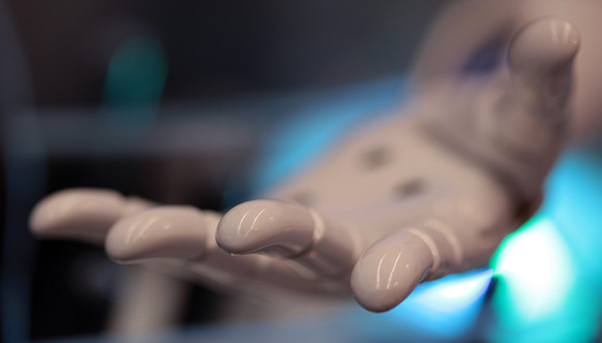Erik G. Sorto, paralysed from the neck down, has been able to shake hands again  thanks to a new thought-controlled robotic arm - and a unique clinical collaboration.
thanks to a new thought-controlled robotic arm - and a unique clinical collaboration.
The innovative new design smoothly controls the robotic limb via a neural prosthetic device, placed in the area of the brain responsible for intentions.
Normally, neural prosthetics are implanted in the brain's movement centre, or the motor cortex. This is the area that directly produces movement, by sending messages to muscles or, in this case, prosthetics. Although this approach allows movement, it doesn't tend to be fast or smooth.
The two silicon chips in Sorto's brain are different. They are implanted in the posterior parietal cortex (PPC), where certain types of movements are planned, and have given him a more natural and flowing movement.
"He really wanted to be able to do the activity of daily living," says Richard Anderson, from the California Institute of Technology. "Simple things, like drinking a beverage at his own rate; starting and stopping at different points."
This trial has allowed Sorto for the first time in over 10 years to shake hands, pick up a glass and even play "rock, paper, scissors".
This robotic control is based on nerve cell activity in the PPC. The researchers found that different cells activate depending on the movement we want to make. For example, one particular nerve cell will change when we want to touch our mouth, and another when want to touch our nose.
By analysing the response of Sorto's nerve cells and comparing them with actions he imagined performing, the team were able to translate the cell patterns into real movements of a computer cursor or robotic arm.
"The chips have 96 recording channels which record [nerve cell] signals. We process those using different computer algorithms to move robotics based on what those signals tell us," explains Anderson.
By also incorporating pattern changes dependent on the planned time and intended speed of movement, the results are much more intuitive and natural. Changes dependent on which arm Sorto imagined using gives hope that a single implant could be used to direct multiple limbs in the future.
Apart from the exciting prosthetic possibilities, this is the first time that PPC nerve cell activity has been measured on a conscious person, who is able to provide information on their thought processes. Using this technique we could gather all kinds of interesting information relating brain signals to activities, and perhaps even predict a person's future actions.
"Our main focus is on helping patients with paralysis. But we think this will be applicable for patients who have suffered strokes or traumatic brain injury too," Anderson concludes.
References
- Previous New Bat-based Sonar System
- Next Paracetamol Harms Unborn Babies










Comments
Add a comment